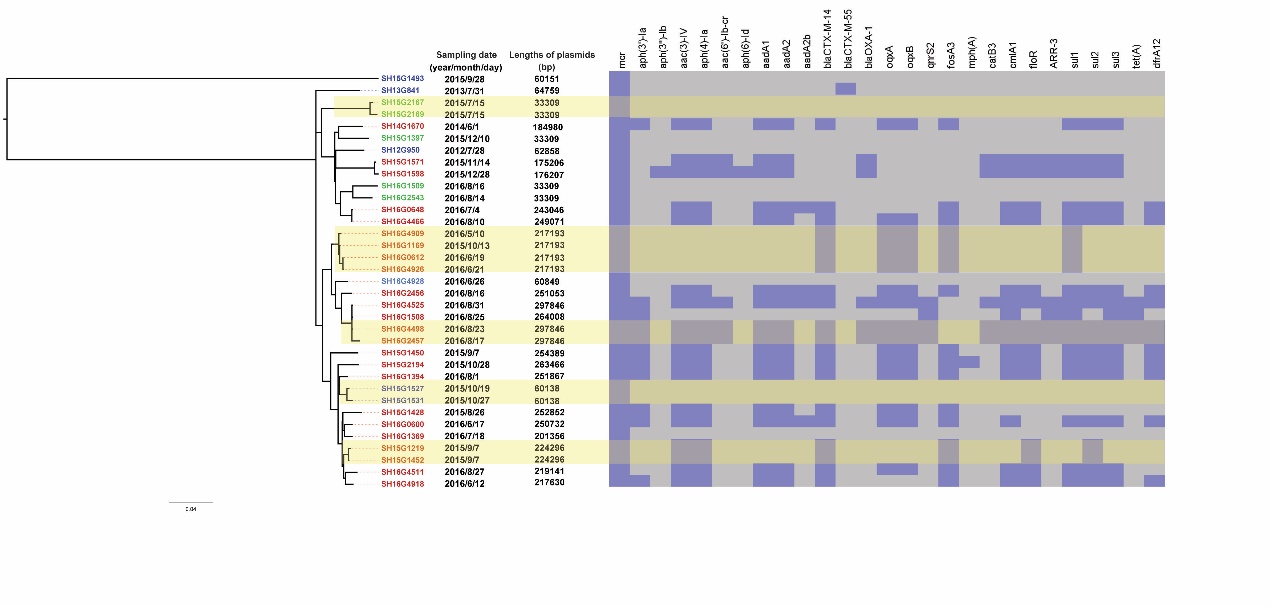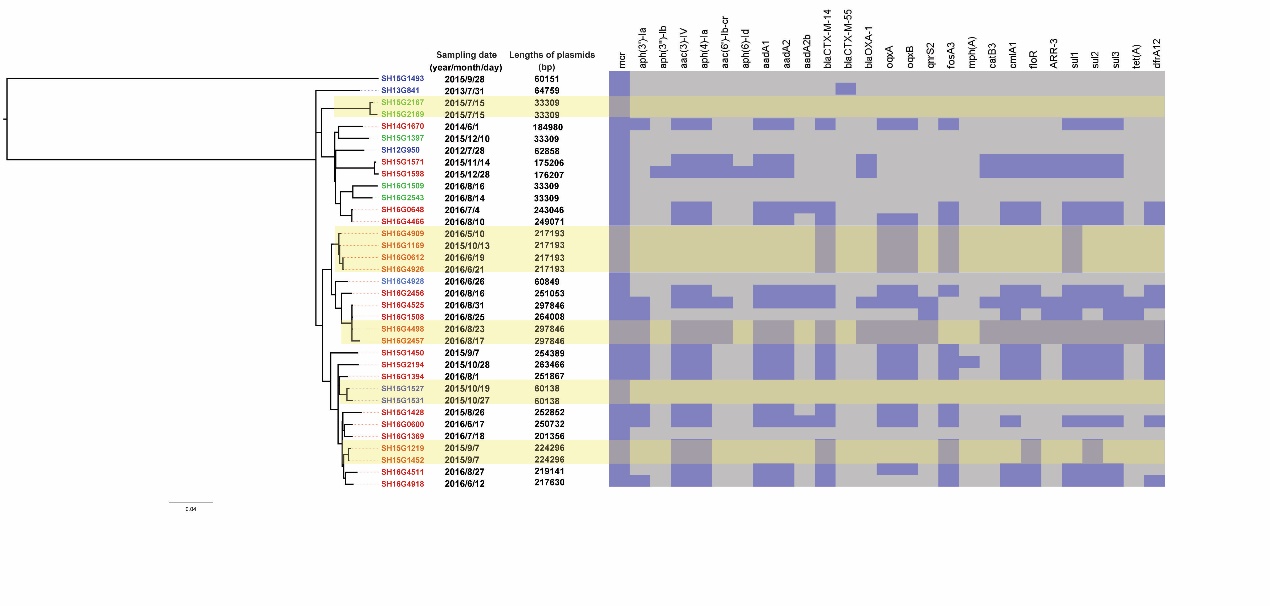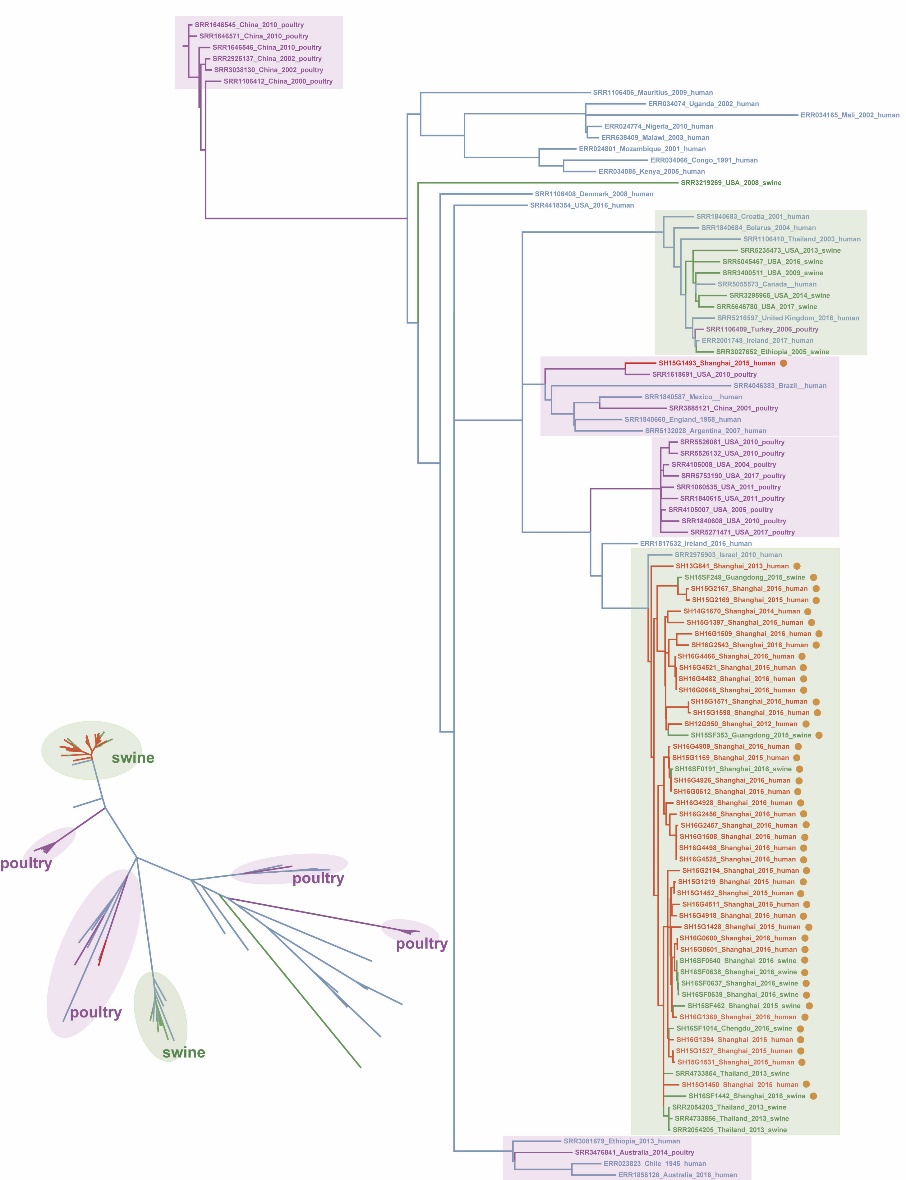多粘菌素被视为抵御耐碳青霉烯肠杆菌感染的最后一道防线,在2017年前,其在养殖业中常被用作饲料添加剂来预防动物疾病和促进动物生长,由此造成较多的耐多粘菌素肠杆菌的出现。2016年初,研究报道发现了一种由质粒携带mcr-1基因介导的多粘菌素耐药机制,随后在养殖动物以及医院感染等来源的肠杆菌中发现了较多的具有此机制的耐药菌。因是由质粒介导,能够使多粘菌素耐药基因在菌株间水平转移,从而造成耐药快速扩散。
沙门菌是一类重要的食源性致病菌,在发达国家和发展中国家均造成了严重的疾病负担。之前曾有一些研究对携带mcr-1耐药质粒的沙门菌株进行过分析,但尚缺乏对具有系统化流行病学监测基础的社区获得沙门菌感染的研究报道。为了解在社区获得感染的腹泻病例中携带mcr-1耐药质粒的沙门菌的基本状况,揭示mcr-1阳性沙门菌在社区感染中的流行病学和分子特征、以及传播状况,由中国疾控中心传染病预防控制所牵头,上海疾控中心、复旦大学儿童医院、北京工商大学以及中国科学院微生物研究所共同组成的研究组,对上海地区2006年至2016年的全年龄组门诊腹泻病人分离的沙门菌菌株开展了研究。这项研究基于上海全范围内筛选建立的哨点医院、连续11年的系统的门诊就诊腹泻病例沙门菌监测项目。所有实验室均经培训、采用一致的病例定义和沙门菌培养鉴定方法。因此,这个研究是基于固定人群的长期和系统的监测,得到了可沿时间纵向比较的社区感染沙门菌分析数据。
纳入本研究的菌株包括了系统收集的12053株沙门菌,涵盖了108个血清型。从中检测到37株携带mcr-1基因质粒的沙门菌,分别来自37个病人。最早出现在2012年,并在2015和2016年迅速增多。尽管社区腹泻病例感染沙门菌中携带mcr-1菌株很少,但显现出携带mcr-1耐药质粒的沙门菌在社区快速增长的趋势和威胁。
37株mcr-1阳性沙门菌存在着明显的血清型偏向性,其中35株为鼠伤寒沙门菌。研究中应用接合转移实验,证明鼠伤寒沙门菌对不同类型携带mcr-1基因的质粒的平均接受能力均高于其它常见血清型沙门菌。
研究组利用长片段测序的Nanopore平台、结合二代短片段测序,对37个编码mcr-1的耐药大质粒进行了测序,组装出了全部质粒的完成图,准确地获悉每个耐药质粒携带的耐药基因谱、位置关系等,并且能够用于准确的质粒基因组相似性分析。
另外,研究中收集了细菌基因组数据库中明确来自养殖动物(猪和鸡)的已测序鼠伤寒沙门菌菌株基因组序列,与这35株菌株共同进行基因组系统进化分析,发现其中34株与猪来源的鼠伤寒沙门菌的一个簇聚集在一起,提示这些mcr-1阳性鼠伤寒沙门菌的感染可能与猪肉制品的消费或供应与食用过程中交叉污染有关,并能够作为分析养殖过程耐药菌传播至人群的一个证据。
这个研究是在一个地区连续11年对哨点医院门诊腹泻病例开展沙门菌监测的基础上的系统回顾研究,发现携带mcr-1质粒的沙门菌有比较特殊的流行病学特征。发现这类耐药菌株近年来增加很快,尤其是这些菌株也对沙门菌感染腹泻治疗常用药物有抗性,其编码mcr-1基因的质粒均具有传递能力,因此如果不及时控制,也将很快形成新的耐药威胁。这也彰显了当前在经济动物养殖中严格限制使用多粘菌素这一措施的必要性。
以上研究以Epidemiologic and genomic insights on mcr-1-harbouring Salmonella from diarrhoeal outpatients in Shanghai, China, 2006–2016发表在EBioMedicine杂志上(DOI: https://doi.org/10.1016/j.ebiom.2019.03.006),中国疾控中心传染病预防控制所卢昕、复旦大学儿童医院曾玫、北京工商大学徐嘉良为共同第一作者,上海市疾控中心许学斌、中国疾控中心传染病预防控制所阚飙为共同责任作者。文章同时配发了评论文章,指出这个研究基于大规模流行病学的分析,显示出携带mcr-1质粒的沙门菌可能会成为肠道感染和食品安全的新威胁。研究提供了社区感染腹泻的沙门菌携带mcr-1的状况、以及基因组和耐药大质粒特征,提示需要加强在动物养殖、食品、社区和医院等环节对这类细菌的监测。
The epidemiologic and genomic insights on mcr-1-harbouring Salmonella presents the potential threat in enteric infection and food safety
Polymyxins are used as the last-resort antibiotics in the treatment of infections caused by multidrug-resistant Gram-negative bacteria. In early 2016, a new mechanism of colistin resistance, mediated by the transferrable mcr-1 gene, was reported from the Enterobacteriaceae from the farming animals and clinics. Plasmid-mediated mcr-1 gene can spread rapidly among strains, resulting in the spread of colistin resistance.
Salmonella is the leading cause of the food-borne disease and food safety issue, can cause serious disease burden in both developed and developing countries. However, understanding on the prevalence and dissemination of mcr-1-positive Salmonella is still limited based on the systematic clinical surveillance in large-scale population. A research team composed of National Institute of Communicable Disease Control and Prevention from China CDC, Shanghai Municipal CDC and other institutions, performed a retrospective study based on a 11-year laboratory-based Salmonellosis surveillance in Shanghai, to determine the prevalence and transmission trend of the mcr-1-harbouring Salmonella in community-acquired infections.
From 12,053 Salmonella strains of 108 serotypes isolated in the laboratory-based surveillance started from 2006, 37 strains with mcr-1¬-harboring plasmids were identified. The mcr-1-harboring Salmonella strain was first detected in 2012, and rapidly increased after 2015. Though the totally positive rate of mcr-1 Salmonella strains were low in this study, the explosive increase occurring after 2015, warning that the threat of expansion in the community of Salmonella with mcr-1-mediated colistin resistance in recent years. This laboratory-based Salmonella surveillance covered all age groups of outpatients; however, 90% (33/37) of outpatients suffering from infection with mcr-1-harboring Salmonella were children aged <5 years. Notably, 26 of the 33 mcr-1-positive strains simultaneously carried extended-spectrum β-lactamase (ESBL) genes, which make them resistant to the common antibiotics such as cephalosporins used for the treatment of diarrhea in children. Most mcr-1 strains are also resistant to fluoroquinolone, the commonly used antibiotics in treatment of Salmonella diarrhea. The resistances to these first-choice antibiotics are just like the given wings (ESBL genes and fluoroquinolone resistant genes) to a tiger (mcr-1 gene), as the meaning of a Chinese idiom. Because of the resistance to cephalosporins and fluoroquinolones, these antibiotics used commonly in clinics may unintentionally promote the co-selection and preservation of colistin-resistant Salmonella strains, although colistin is rarely used in the treatment of salmonellosis.
This study also found a highly skewed serotype distribution of the mcr-1-positive Salmonella strains; 35 of 37 mcr-1¬-positive strains were serovar Typhimurium. The finding was supported by the results of the mcr-1-harbouring plasmid conjugation experiments conducted in this study, which show that the acquisition of mcr-1 plasmids by S. Typhimurium was ten and seven times higher, respectively, compared with two other common serovars, Enteritidis and Derby.
The study also obtained the complete sequences of all 37 mcr-1-harbouring mega-plasmids by short- and long-read sequencing strategies. Therefore, the plasmid structure and resistant genes carried on the plasmids were all clear and facilitated the precise plasmid comparisons. Core-genomic SNP phylogeny combined with mcr-1-harbouring plasmid sequence comparisons revealed genome subtyping clusters, suggesting the presence of mcr-1-harbouring Salmonella outbreaks in the community and that the rapid expansion of colistin-resistant strains in the community presents a potential public health threat. Most mcr-1-positive S. Typhimurium strains (34/35) were clustered together within the swine strain branch in the phylogenetic tree, providing strong genome epidemiology-based evidence that the consumption of pork or the cross-contamination of pork and other foods in food processing is the likely contamination source of mcr-1-harbouring S. Typhimurium. Before 2017, polymyxins were often used as feed additives to prevent animal diseases and promote animal growth, the result highlighted the significance to restrict the use of polymyxins in animal breeding.
The findings were reported as “Epidemiologic and genomic insights on mcr-1-harbouring Salmonella from diarrhoeal outpatients in Shanghai, China, 2006–2016” (DOI: https://doi.org/10.1016/j.ebiom.2019.03.006) published in EBioMedicine. Xin Lu (National Institute for Communicable Disease Control and Prevention), Mei Zeng (Children's Hospital of Fudan University), and Jialiang Xu (Beijing Technology and Business University) shared the co-first authors, Xuebin Xu (Shanghai Municipal CDC) and Biao Kan (National Institute for Communicable Disease Control and Prevention) are the co-corresponding authors of this paper.















 2019-05-22
2019-05-22
 【打印】
【打印】

